
Constr_materials
.pdf12.NONMETALLIC STRUCTURAL MATERIALS
12.1.RESTRICTIONS IN METALS PERFORMANCE
Metal structural materials are strong and reliable, technological and in many cases are economically effective. But metals possess, nevertheless, a number of the essential lacks limiting their application.
First, many metals and alloys are subject to corrosion in excited environments. High heat and electric conductivity of metals are not advantages in all cases as heat insulating materials and dielectrics are necessary, too. Metal materials do not always provide necessary hardness and wear resistance under friction conditions. In many cases hot-resistance and fire resistance of metals are insufficient. The strongest metal materials have the high density, i. e. do not allow getting the high unit strength necessary for air craft and the space engineering. At last, the technological route from ore mining to a finished metal product takes very long time, includes huge number of operations and is rather labour-consuming.
Therefore in many cases non-metallic materials are applied. They are usually subdivided into polymers (plastic), ceramics and glass what was told in the chapter 1.
12.2. POLYMERS, OR PLASTICS
Plastic is the artificial solid material made on the basis of organic polymeric binding substances. Have the big molecular weight (above 10,000).
Composition of plastics
1)Binding material is an obligatory component. These are synthetic resins or ethers. Simple plastic (organic glass, polyethylene, polypropylene) consist almost of one binding substance.
2)Filling material. Content of fillings can reach 70 %. They can be powder (soot, graphite, talc, wood flour), fibrous (cotton, glass, asbestos fibres), sheet (a paper, fabrics, a wood veneer). Fillings raise mechanical strength, reduce cost of plastic and give them the necessary operational properties.
3)Stabilizers. They are necessary, that macromolecules of polymers did not change the spatial structure, and properties of plastic did not vary eventually.
4)Softeners (plastifiers). They are added in quantity not more than 20 %. They improve moldability of plastic, reduce brittleness. Usually they are oleinic acid, stearin, dibutylmetaftalat.
121
Created with novaPDF Printer (www.novaPDF.com). Please register to remove this message.
5)Hardeners. They are added into plastic based of thermosetting resin as catalysts of hardening. These are organic peroxides.
6)Special additives. These are dyes, greases, antistatics, additives against burning, against a mildew, etc.
Properties of plastics
Advantages of plastics in comparison with other structural materials
are: |
|
|
low density; |
|
high unit strength σT/γ; |
|
chemical firmness; |
|
electrical insulating properties; |
|
heat insulating properties; |
|
less labour input of plastic processing in comparison with |
processing of metals: a product and a material are created simultaneously; |
|
|
less quantity of a waste, than at processing of metals (material |
utilization rate is not less than 0.9); |
|
|
as a rule, finishing operations are not necessary. |
Replacement of metal details with plastic ones gives the weight and labour input decrease by 4-5 times, the number of operations is decreased by 5-6 less. The cost price is decreased by 2-3 times.
The main disadvantages of plastics:
limited thermostability: the maximum temperature of operation for thermoplastics is 250 С (ftoroplast), and for thermosetting plastics – nearby 400 С (fiberglass);
low stiffness and toughness;
propensity to ageing, i. e. properties change eventually.
Structure of plastics
Structural unit in polymers is the macromolecule consisting of huge number of identical groups of atoms – mer units. Each mer unit is the changed molecule of initial low-molecular substance – a monomer. In polymer structure molecules of a monomer are united with each other and form long chains in which atoms are connected by covalent bonding.
For example, polymer polyethylene (–CH2–CH2–)n which macromolecules consist of mer units CH2, is produced by polymerization of n molecules of a monomer, gas ethylen CH2=CH2. The number n makes thousand.
In schemes of macromolecules covalent bonding is shown by a dash: “–“ (see Fig. 12.1).
122
Created with novaPDF Printer (www.novaPDF.com). Please register to remove this message.
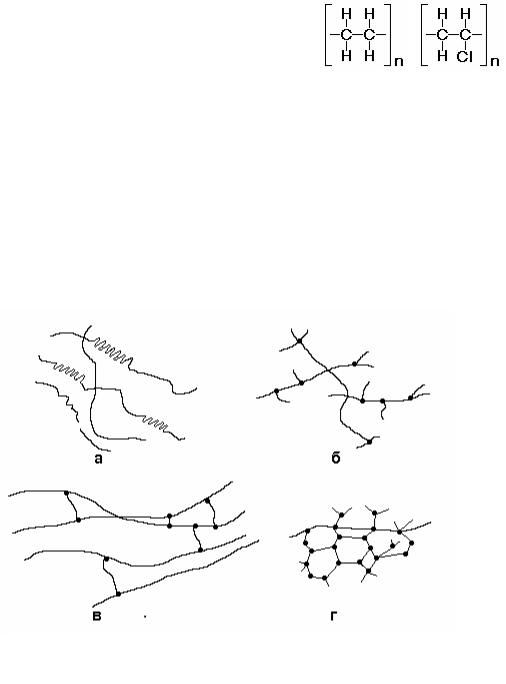
Properties of polymers are defined not only by a chemical compound,
but also by a structure and a relative positioning of molecules. |
|
|
Linear macromolecules are chains with |
|
|
the relation of length to the cross-section size |
|
|
above 1000 (Fig. 12.2, a). They can form |
|
|
zigzags, spirals or to be mixed up. Between |
а |
b |
macromolecules there is the weak secondary |
Figure 12.1 Schemes of |
|
bonding caused by van der Waals forces. |
polyethylene (а) and |
|
Molecules of thermoplastics have such a shape. |
polyvinyl-chloride (b) |
|
In polymers with the branched structure |
macromolecules |
|
attractive forces between macromolecules are
weaker, polymers are less strong (Fig. 12.2, b). They are more fusible and friable.
In polymers with a crosslinked structure there is covalent bonding between molecules (Fig. 12.2, c). They are strong, not fusible, insoluble (can be softened and bulk up only).
|
|
b |
|
а |
|||
|
|
|
|
d |
|
c |
|||
|
|
Figure 12.2 Molecular structures of polymers:
а – linear; b – branched; c – crosslinked; d – network
In polymers with a network structure all linear sites are connected by cross-section covalent bonding. In this case the product represents a huge spatial molecule (Fig. 12.2, d). Such polymers are brittle, thermostable and do not dissolve (not soften and swell). These are thermosetting polymers.
The structure of a linear macromolecule is schematically shown in Figure 12.3.
123
Created with novaPDF Printer (www.novaPDF.com). Please register to remove this message.
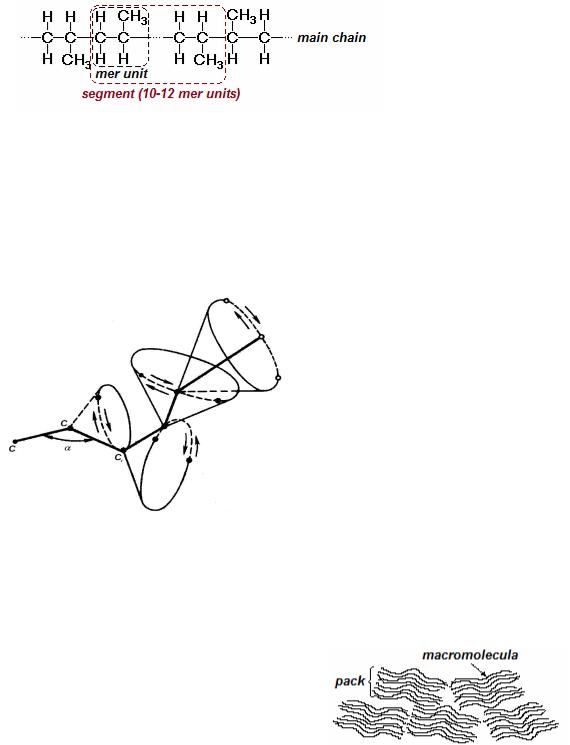
Energy of covalent bonding between atoms in the main chain is great: Ebond = 350 kJ/mol. The energy of secondary bonding is approximately 30 times lower. Therefore
macromolecules can be shifted with respect to each other rather easily. Besides, a macromolecule is a flexible structural unit since its segments can rotate independently while keeping the valence angle α constant (Fig. 12.4). This is the reason behind the instability of polymers properties: huge flexible macromolecules cannot maintain the set of spatial position for a long time.
Polymers are able to form the ordered arrangement of macromolecules. The ordered structure appears under the influence of attractive forces between molecules and thermal movement of molecules. This phenomenon reduces total internal energy of a system.
One variant of the ordered packing is formation of chain-packed structures. Packs represent a consecutive arrangement of macromolecules one after another (Fig. 12.5). Packs move as a unit, but
become unstable upon heating and stresses applied.
More complex and steady ordered regions are called crystals. In the beginning macromolecules fold into
tapes at the expense of repeated turns of segments around. Tapes combine into plates which layer and form crystals. In polymer volume there is an alternation of amorphous and crystal regions (Fig. 12.6). Polymer never reaches the absolute crystallization.
Crystal polymers are stronger at loading and heating.
124
Created with novaPDF Printer (www.novaPDF.com). Please register to remove this message.
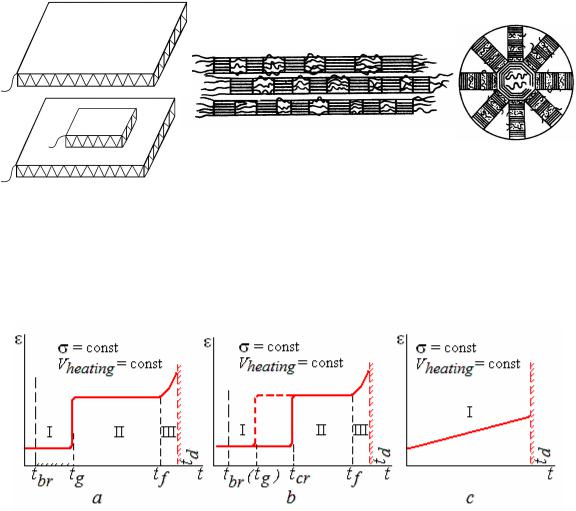
ПластинаPlate
а |
b |
c |
Figure 12.6 Various crystal shapes:
а – crystal formation from plates; б – fibrillas; в – spherolith
Polymers behavior upon heating
Thermomechanical curves (at constant stress and speed of heating) show deformation value ε versus temperature.
Figure 12.7 Thermomechanical curves:
а – amorphous thermoplast; b – crystalline thermoplast; c – thermosetting polymer
In Figure 12.7, a the behaviour of amorphous thermoplastic polymer upon heating is shown. At low temperatures polymer is in glassy state (field I) and behaves as an elastic solid body. Then heating translates it into a viscoelastic state (field II). Here the polymer strain degree can reach hundreds percent (800 % for rubbers), but it is reversible. Upon the further heating polymer behaves as a viscous liquid (field III). Deformation is irreversible. It is an area of plastics processing. Above temperature of thermal decomposition of polymer td covalent bonding in macromolecules are broken off, low-molecular compounds deposit, and polymer decomposes. However upon cooling thermoplasts have a polymerization, structure and properties of polymer are restored.
Figure 12.7, b shows behaviour of the thermoplastic polymer capable of crystallisation. Below the crystallisation temperature tcr polymer has the
125
Created with novaPDF Printer (www.novaPDF.com). Please register to remove this message.
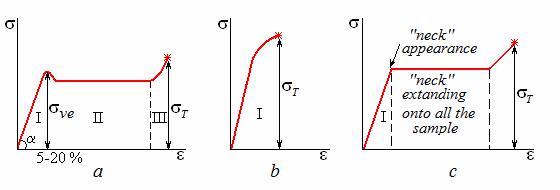
ordered structure, above this temperature it transforms to amorphous state. As it is necessary to spend energy for destruction of crystal structure, crystal polymer becomes viscoelastic absorbing more heat as compared to amorphous one.
In Figure 12.7, c the behaviour of thermosetting polymer when heated is shown. It is capable of deforming slightly only in elastic area, and then, upon heating above td, it decomposes irreversibly. When cooled, polymerization does not occur, properties are not restored.
Area of working temperatures for polymer lies below the glass transition temperature tg though it can work for a short time above this temperature. But it is necessary to consider that below the brittleness temperature tbr polymer fractures in a brittle manner (a stress value necessary for starting deformation exceeds tensile strength). Thus, polymer works reliably under loading in the range of temperatures from tbr to tg. The wider this interval the better it is for plastics.
It is necessary to understand that temperatures of polymer transitions from one state to another are not constants (for example, tg and tf – fluidity temperature). They depend on conditions of loading. The higher is the strain rate, the higher are these temperatures. It is the feature that differs plastics from alloys.
Polymers behavior under loading (stress-strain diagrams)
Amorphous linear polymer in a glassy state is capable for big enough elastic strain degree – up to 20 % (field I in Fig. 12.8, a). Polymers have their modulus of elasticity E (tg α) much lower as compared to metals. Viscoelastic strain may achieve hundreds percent (Fig. 12.8, a, field II). It occurs on the account of unbending the folded macromolecules. Further more intensive loading leads to the displacement of macromolecules with respect each other. It is viscous liquid state (Fig. 12.8, a, field III).
Figure 12.8 Stress-strain diagrams for polymer materials:
а – amorphous thermoplast; b – thermosetting polymer; c – crystalline thermoplast
126
Created with novaPDF Printer (www.novaPDF.com). Please register to remove this message.
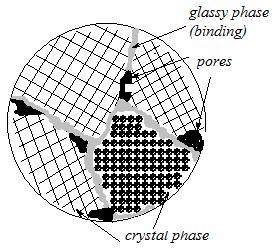
Under mechanical loading and before destruction, polymer passes through the same stages as those existing during heating. However, the energy needed for transition to a new state is acquired from the deformation work instead of the heat source.
Thermosetting polymer with network structure is capable of experiencing only elastic deformation until the moment of destruction (Fig. 12.8, b). Such polymers have the higher stiffness E and strength σT than thermoplasts.
Crystalline polymer at temperature below tcr after uniform elastic deformation (Fig. 12.8, c, field I) forms local narrowing called “neck” which gradually extends onto the whole sample. Thus there is a change of crystal structure fixing the residual strain. Stiffness and strength of crystalline polymer is higher that of the same polymer in amorphous state.
12.3. CERAMICS
Ceramics is the inorganic solid materials produced by hightemperature burning from formed mineral mixtures. It is possible to say that the ceramics is all the materials which are not polymers and metals. In ceramic materials there is either covalent or ionic bonding between the atoms.
For ceramics production there is a large quantity of natural compounds; they make up to 85 % of earth crust. The content of silicon only is about 40 %. In the Tomsk region there are own resources for ceramics manufacture such as alumina in Achinsk, the Tugansky deposit of zirconium sand.
The modern engineering uses more than 7000 various products made of ceramics starting from ferrite of size about a pin head and thin films for touch devices to huge insulators for
electric power lines.
Ceramics structure |
|
|
|
Basis of building, household |
|
||
and art ceramics is natural clay. |
|
||
The technical ceramics has more |
|
||
homogeneous structure; it is made |
|
||
from oxides or oxygen-free |
|
||
compounds. |
|
|
|
While |
burning |
(1200- |
|
2500 С) structure and properties of |
|
||
ceramic materials are |
formed |
|
|
simultaneously. Ceramics always is |
Figure 12.9 Ceramic structure |
||
|
|
|
127 |
Created with novaPDF Printer (www.novaPDF.com). Please register to remove this message.
multiphase substance: it contains crystal, glassy and gas phases in various proportions (see Fig. 12.9).
Crystal phase represents chemical compounds or solid solutions. It is the basic part of structure and defines strength, hot-resistance and other major properties of ceramics.
Glassy or amorphous phase is a binder; its quantity can vary largely: from 1 to 40 %. It reduces strength and hot-resistance, but facilitates the technology of production.
The gas phase is in ceramics pores. By the volume content of pores the ceramics is subdivided into porous and dense. For engineering purposes the dense ceramics is more often used. But also it contains a certain share of pores.
Properties of ceramics
Advantages of ceramics are:
high hardness and wear resistance;
high working temperatures (to 3500 С);
high corrosion resistance in various environments;
low heat and electric conductivity: ceramic materials are dielectrics and heat insulators;
low density; ceramics are rather light materials.
The basic lack of ceramics:
high brittleness. Impact strength of ceramics is approximately 40 times less, than metals have. Brittleness limits its application in the technique. The ceramic goods have low strength under stretching and bending. Ceramics does not plastically deform.
High strength and melting temperature of ceramic materials are caused by high energy of interatomic bonds. These are either covalent or ionic compounds. Strong interatomic bond defines high resistance to deformation, therefore special strengthening processing is not required for ceramics.
To increase the impact strength of ceramics, there are various approaches. First of all, the amount of pores in a ceramic material should be as low as possible because they are sources of cracks. For today, the following basic methods of improving the fracture toughness of ceramics are developed:
alloying or modifying,
strengthening by disperse particles,
strengthening by whiskers of stronger ceramics,
“blunting” of cracks at the expense of set of microcracks creation: in this case the main crack does not develop.
128
Created with novaPDF Printer (www.novaPDF.com). Please register to remove this message.
To find a solution to this actual problem of improving the resistance to fracturing (toughness) of ceramics, materials scientists are working all over the world including Tomsk scientists at the Institute of Strength Physics and Materials Science SB RAS.
Ceramics classification and application
The technical ceramics can be subdivided into 3 groups: oxide ceramics, oxygen-free ceramics and metal ceramics (cermets).
1) Oxide ceramics is made from oxides of various elements: Al, Mg, Zr, Si, Be, U. It consists basically of a crystal phase and pores. The glassy phase appears only at the expense of impurity.
Oxide ceramics is hard, fire-resistant, and chemically resistant in acids, alkalis, on air. Working temperatures make 0.8-0.9 of the fusion temperatures 2000 to 3300 С. But it does not withstand the sharp changes of temperature.
The porous ceramics of this group is applied as heat insulator material and fire-resistant lining for chambers of combustion, metallurgical furnaces and ladles (silica, magnesite, fireclay bricks). The foam ceramic thermal protection of space shuttle “Buran” had only 5 % of a material and 95 % of pores filled with inert gas. Porous ceramics is applied also for making filters for various liquids (water, wine, oil).
Ceramics based on aluminum oxide Al2O3 is called emery. It is applied in the most different areas of engineering:
|
radomes of radar scanners, |
|
bearings for furnace rollers, |
|
inputs and supporting devices for heaters in thermal furnaces, |
|
electroinsulators, |
|
nozzles of argon-arc torches, spray jets for water injection into a |
well (pressure 15 MPa), sandblasting and shot-blast units, |
|
|
dies for wire drawing, |
|
thread carriers in the textile industry, |
|
cutting tools, |
|
distributors and washers in the household sanitary technician, |
|
face seal rings for pumps. |
The ceramics based on zirconium oxide ZrO2 has very important feature. ZrO2 experiences 3 polymorphic transformations when heated: the monoclinic lattice turns into tetragonal, and then to the cubic. The tetragonal lattice can be stabilized at low temperatures by means of modifying. In this case, the phase transformation begins at the expense of the applied stress. Such modified ceramics has a tensile strength 3000 MPa together with criterion of crack resistance K1C = 20-25 (for ordinary ceramics it is not higher 4). ZrO2 is used for solid-oxide fuel cells (for electric power generation), gauges of the oxygen content in molten steel.
129
Created with novaPDF Printer (www.novaPDF.com). Please register to remove this message.
In instrument making, the electrical engineering and electronics the so-called fine ceramics is applied. It is dense and fine-grained (the size of grains 1-5 µm). These are, for example, ferrites – high-frequency magnetically soft materials from iron oxides FeO·Fe2O3, sintered or melted into a single crystal without pores. Magnetically hard ferrites also exist. Electrical porcelain ceramics is applied for insulators. There is a special condenser ceramics (ultra porcelain, steatite TiO2) with high value of dielectric permeability ε.
2) Oxygen-free ceramics are carbides MexCy, nitrides MexNy, borides MexBy, etc. These are refractory compounds, their fire resistance reaches 3500 С. Hardness comes nearer to hardness of diamond. They possess high wear resistance and heat resistance.
Silicon carbide SiC is a hard, chemically resistant, light, heat resisting material. It is used for heaters of furnaces, thermowells, blades of gas turbines, parts of internal combustion engine, grinding circles, coatings on graphite.
Silicon nitride Si3N4 is resistant in the fused metals and slags. It is applied for parts of gas turbines, heat resisting tools, crucibles, crystallizers, parts of pumps for pumping of the fused metals.
3) Metal ceramics, or cermets, are manufactured by mixing of powders of refractory ceramic compound and metal. Then the mixture of powders is pressed and sintered. Metal plays a binding role; it improves both plasticity and toughness. Thus the flexure toughness σT increases, too. The binders are made of cobalt, nickel, iron, molybdenum. The ceramic component can be both oxide and oxygen-free types.
Metal ceramics are widely applied for cutting hard alloys. Also they are used for manufacturing cutting plates for mills, drills and cutters; and also stamps, dies, the boring tools. They consist of carbides WC, TiC, TaC and cobalt for binder. Cermets Cr7C3 – Ni, Al2O3 – Cr, BeO – W are applied as heat resistant materials.
12.4. COMPOSITE MATERIALS
Composite materials (composites) relate to a new class of light and highstrength materials with the high resistance to crack propagation.
Composites surpass all traditional constructional materials in specific strength and specific stiffness. Besides, they retain high strength at elevated temperatures and resist to failure by fatigue.
Composites are complex materials made of components whose structure and properties are strongly different. They are not soluble in each other and separated by clearly marked boundary.
The principle of composite structure is borrowed from nature: trunks of trees consist of rigid cellulose fibres and soft lignin, bones of the humans and
130
Created with novaPDF Printer (www.novaPDF.com). Please register to remove this message.
